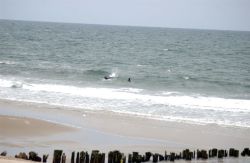Jamaica Bay and the Rockaways
Brant Point Wildlife Sanctuary
Brant Point Wildlife Sanctuary, a wetland area of Jamaica Bay, was established as a protected area under the Buffer the Bay program, a joint effort by the Trust for Public Land and the New York City Audubon Society. The goal of the late 1980s initiative was to reclaim land around Jamaica Bay in order to protect New York City’s largest and most vital natural marshland. Brant Point Wildlife Sanctuary is an integral part of the Buffer the Bay program.
Jamaica Bay is an 18,000-acre wetland estuary surrounded by the Rockaway Peninsula to the South, Brooklyn to the West, and Queens to the East. Comprising an area almost equal to that of Manhattan, the bay consists of numerous islands, a labyrinth of waterways, meadowlands, and two freshwater ponds. The wetlands provide a unique environment for both wildlife preservation and urban recreation. Enclosed by the Rockaway Peninsula and protected from the Atlantic Ocean, the region currently hosts over 325 species of birds, 50 species of butterflies, and 100 species of fish. A favorite stop for migratory waterfowl, the area is a key part of the regional ecosystem.
Through the efforts of Parks Commissioner Robert Moses (1888-1981), much of Jamaica Bay was placed under Parks jurisdiction in 1938. Originally, Jamaica Bay Park covered over 9,151.8 acres of wetlands and beaches. Determined to maintain the park’s natural state, Commissioner Moses defeated several plans to alter the area’s environment and topography, including a proposal to create a large industrial port near the site. Following the establishment of the Jamaica Bay Wildlife Refuge, Herbert Johnson was appointed as its resident superintendent in 1951. Johnson worked diligently to preserve and restore the natural nesting grounds of waterfowl and shore birds. The resurrection of the nesting grounds has led to the return of increasing numbers of species each year. Notables include the return of the snowy egret (Egretta thula) and the glossy ibis (Plegadis falcinellus). On March 1, 1974, over 9,000 acres of the site’s parkland were transferred to the newly created Gateway National Urban Recreation Area (a congressional initiative designed to create a National Seashore in New York and New Jersey). The Gateway National Urban Recreation Area is presently comprised of Jamaica Bay along with parks in Breezy Point, Sandy Hook, and Staten Island. This park is maintained by the National Parks Service.
Brant Point Wildlife Sanctuary, located on the southern portion of the bay, lies on Bayfield and Decosta Avenues. The area was assigned to Parks in 1992. An additional parcel of land was acquired by condemnation for the City of New York in 1997 and then transferred to Parks. The area remains undeveloped in order to preserve the natural wildlife habitat and protect Jamaica Bay.
Check out your park's Vital Signs
Clean & Safe
Green & Resilient
Empowered & Engaged Users
Share your feedback or learn more about how this park is part of a
Vital Park System

Know Before You Go
Ecology Park is only open at certain times of year when Parks staff are present in order to protect this unique landscape. Want to visit? Check out our Stewardship Projects page for restoration, planting, and educational events.



